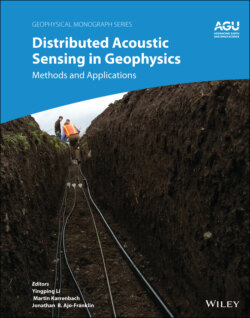Читать книгу Distributed Acoustic Sensing in Geophysics - Группа авторов - Страница 30
1.3.3. Field Trial Results
ОглавлениеA comparison of DAS with standard and engineered fiber for a seismic sweep signal is presented in Figure 1.31. This measurement was provided using two different fibers placed side by side in the same optical cable, so the elongation of both fibers was identical. The top graphs (a) and (c) demonstrate the difference between the time‐distance representation; the right panel (c), which represents engineered fiber, is visibly cleaner than the left panel (a). The detected seismic signal has the same shape (around 10 nm peak to peak for a channel 898) for engineered (d) and standard (b) fiber, except noise. Some change in amplitude (20%) can be explained by incomplete averaging of the DAS signal over distance, as is shown in Figure 1.7. There was less variation in the amplitude level for engineered fiber, and this stability can be important for 3D VSP, as was shown in Figure 1.21.
A comparison of DAS acoustic noise with standard and engineered fiber is presented in Figure 1.32. Noise spectral density versus distance is practically constant for engineered fiber (b) but varies significantly for standard fiber from channel to channel along distance (a). In other words, we can conclude that standard DAS noise depends on fiber randomness and can be far from the average value, but engineered fiber DAS noise is predictable. The SNR difference is emphasized by the signal Fourier transform in the bottom chart (c): the noise reduction for engineered fiber is nearly 20 dB as was expected from shot noise estimation (Equation 1.46).
Figure 1.31 Comparison of DAS with Rayleigh scattering [(a) and (b)] and engineered fiber [(c) and (d)] for a seismic sweep signal. Acoustic signals are measured in optical phase radians.
Figure 1.32 Comparison of DAS noise spectrums with Rayleigh scattering (a) and engineered fiber (b). Panel (c) represents acoustic noise spectrum density with respect to 1 rad/Hz0.5.
Source: Based on Richter et al. (2019).
Fine spatial resolution in combination with good sensitivity gives DAS a significant advantage for detection of microseismic events, particularly where a geophone chain cannot be readily positioned. Such measurements are used in fracking jobs, where a wireline fiber optic cable is pumped down into an already completed observation well (Richter et al., 2019). This gives the possibility to determine the frack height and well interference with unprecedented clarity.
A typical microseismic event is presented in Figure 1.33, where both S‐ and P‐waves are clearly visible, such that the distance from observation well to fracking event can be easily detected. Figure 1.34 shows how the same installation can be used to detect a “frac hit,” where a fracking zone and strain extends slowly from the well undergoing treatment to the observation well. This new data allows completion engineers to map the depth, azimuth, and speed of the fractures and feed that information back into the fracture models to validate and optimize the designs for the next operation.
Figure 1.33 Microseismic event in observation well detected by DAS with engineered fiber.
Figure 1.34 Example of low frequency (down to millihertz level) “slow strain” data, showing a fracking hit on an observation well from a well undergoing treatment. The time‐averaged signal cross‐section along the white line is shown in the bottom panel.
Figure 1.35 Comparison of geophones (left panel) and DAS with engineered fiber (right panel).
The results from a VSP survey in a carbon sequestration well (Correa et al., 2017) demonstrate that DAS with engineered fiber has the potential to provide similar, or even superior, quality data sets as compared to conventional geophones. An important aspect is that, due to the higher spatial sampling, DAS data has the capability to provide more detailed velocity information as compared to geophones. This conclusion was expected from the preceding theory and is illustrated in Figure 1.35, which demonstrates even a finer reflection structure from DAS than from geophones.
In summary, we have estimated the main DAS performance parameters for standard and engineered fiber and provided field data that correspond to the theoretical predictions of improved sensitivity and dynamic range.
